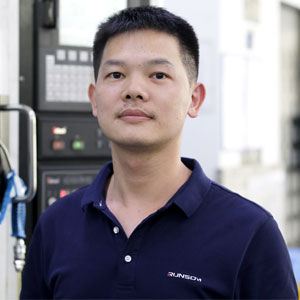Heat treatment is applied to most metal alloys, in order to improve key physical properties like hardness, strength and machinability drastically. These improvement due to materials micro-structure modifications and surface chemical composition. These treatment including heating alloys at extreme temperatures with controlled cooling conditions. Final physical properties of metal alloys will be affect greatly by heating temperature, heating time and cooling rate. We provide different heat treatment for most common used metal alloys in CNC machining, improve various properties of final CNC parts, and assist you to select the perfect material for your applications.

Heat Treatment Application Time
Heat treatments are widely applied to metal alloy throughout CNC machining manufacturing process. For CNC machined parts, heat treatments are typically applied both before and after CNC machining.
Before CNC machining: once standardize grade of metal alloys on request is readily available, we can machine metal materials directly form stock. This will reduce leading times.
After CNC machining: normal heat treatment are applied as finishing step after forming, in order to increase hardness of metal materials. In reason of high hardness will reduce machinability of metal materials. These case are standard practice for steel parts CNC machining.
Common Heat Treatments for CNC Materials
Annealing, Stress relieving & Tempering
Annealing, tempering and stress relieving are process of heating metal alloys into a high temperature and subsequently cooling materials at slow rate, all these processes are normally in air or ovens. They are differed in material heating temperature and manufacturing process orders.
Annealing: metal materials are heated to a very high temperature, then cooled slowly to achieve desired micro-structure. Annealing is always applied to most metal alloys after forming process, it is prior to any further processing to soften metal and increase machinability. Most CNC materials will obtain annealed state properties without another heat treatment.
Stress relieving: it will heat parts to a high temperature (lower than annealing), this process is applied after CNC machining process, in order to eliminate residual stresses form CNC machining process, produce CNC parts with more consistent mechanical properties.
Tempering: it also heat parts at temperature lower than annealing, it also applied after quenching process of mild steels (1045 or A 36) and alloy steels (4140 or 4240 ), in order to reduce metal brittleness and improve mechanical performance.
| Heat Treatment | Purpose | Compatible Materials |
| Annealing | Improve metal alloy machinabiltiy | All metal alloys |
| Stress relieving | Release residual stress from mechanical deformation | All metal alloys |
| Tempering | Reduce brittleness after quenching | Mild steels (1045,A36) Alloy steels (4140,4240) Tool steels (A2) |
Quenching
Quenching is heating metal alloys to a very high temperature, and cooling them rapidly, usually in the way of dipping materials into oil or water, or exposing to cool air stream. The rapid cooling process will create micro-structure changes in heating up area, result very high hardness in parts surface. CNC parts are usually quenched as final process in manufacturing process after CNC machining, in reason of increased hardness will make metal materials vary difficult to cut.
Tool steels are quenched after CNC machining to get high surface hardness properties. Then additional tempering process is applied to control final hardness. Such as tool steel A2 can reach 63- 65 HRC after quenching, and also can be tempered to 42- 62 HRC. Tempering can prolong parts service life, as it can reduce the brittleness, the best results are achieved in hardness area of 56-58 HRC.
| Heat Treatment | Purpose | Compatible Materials |
| Quenching | Increase metal alloy hardness | Mild steels (1045,A36) Alloy steels (4140,4240) Tool steels (D2,A2,O1) |
Precipitation Hardening
Precipitation hardening normally including three steps process: metal materials are first heated to high temperature, then quenched, and finally heated at lower temperature for long period time. This gives rise to alloy elements, which appear as discrete particles of different composition, disolve and distribute uniformly on metal matrix. After precipitation hardening, metal alloys strength and hardness increase dramatically. Such as aluminium 7075, we can witness the effects of precipitation as following table:
| Aluminium 7075(Tempered) | Aluminum7075(Precipitation Hardened) | |
| Ultimate Tensile Strength | 280 MPa | 510-540 MPa |
| Yield Strength | 140 Mpa | 430-480 MPa |
| Elongation | 9-10% | 5-11% |
| Hardness | 68 HV | 175 HV |
Not all metals materials can be heat treated with this method, it is more suitable for high-performance application with compatible super-alloys.
| Heat Treatment | Purpose | Compatible Materials |
| Precipitation hardening | Increase metal alloy hardness &strength | Aluminum alloys (6061, 6068, 7075) Stainless steel (17-4) |
Case Hardening & Carburizing
Case hardening is a heat treatment, which can create high hardness on parts surface with soft underline materials. This process is preferred than overall hardness increase method of quenching, as harder parts are more brittle too.
Carburizing is the most common case hardening treatment. Its process includes heating mild steels in carbon-rich environment, then subsequently quenching to lock carbon on metal matrix. This will increase steels surface hardness, similar as anodizing on aluminum alloys.
| Heat Treatment | Purpose | Compatible Materials |
| Case hardening & Carburizing | Increase metal parts surface hardness, keep core material soft | Mild steels (1018,A36) |
How to Specify Heat Treatment
Once you place CNC orders, there are 3 ways for heat treatment request:
- Manufacturing standard reference: many heat treatments are standardized and widely applied.
- Specify required hardness: this is common method of specifying heat treatments for tool steels and case hardening. This can indicate heat treatments after CNC machining.
- Specify heat treatment cycle: you can modify material properties for your application, then communicate to your supplier once place orders.

